 |
surfresearch.com.au
the catalogue #223
|
| home | catalogue | history | references | appendix |
 |
surfresearch.com.au
the catalogue #223
|
| 1978 Kewarra Surfboards : Jet Bottom by Erle Pedersen 5 ft 5' | #232 |
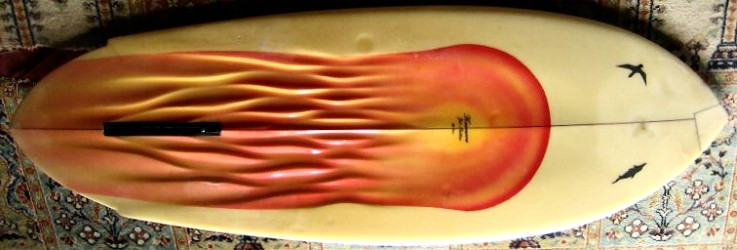
| Length: |
5
|
feet | 5 | inches |
Ld: 5ft
|
6'' |
| Width: |
20 1/2
|
inches | Wide Point: |
+ve 2
|
inches | |
| Nose : |
19 1/4
|
inches | Tail |
20 1/4
|
inches | |
| Thickness: |
2
|
inches | Pod: |
12
|
inches | |
| Weight/ | inches | Volume: | inches | |||
| Nose/L: | inches | Tail/L: | inches | |||
| Chamfer: |
2
|
inches |
| FIN
Fin box : 8'' Simon comments on the possible fin... Who knows where the fin is now. I probably gave it away, otherwise I would still have it. Thrusters came along. I didn't ride a single fin again for at least 10 years. Luckily I have a photo which I'll send to you. It's a Greenough style thing, high aspect, well foiled, but as i recall, not especially flexy. Erle was and I'm sure still is, the fin master - both at laying up beautiful panels and shaping and foiling. He was working for Midget (Farrelly) making fins when we left Sydney. Photograph right, by Simon Chipper |
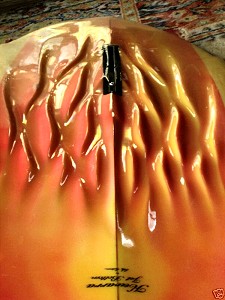 |
| DECOR
DECAL/S Deck: Two of Kerrawa Surfboards black script and bird/dolphin images on the rails forward of the wide point. by Erle Pedersen small black script on the tail Bottom: ?black script at wide point. MARKINGS Deck: Bottom: COLOUR: Deck: Red and yellow full deck foil spray. Bottom: Red and yellow spray featuring concave and channels. Photograph right, by Simon Chipper |
 |
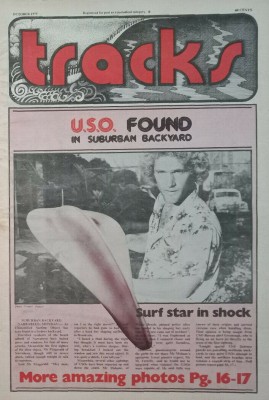 |
Tracks Number 61 October 1975. |
Page 17 Unidentified
Surfing Object
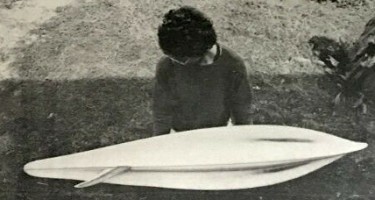 Future Shapes by Erle Pedersen |
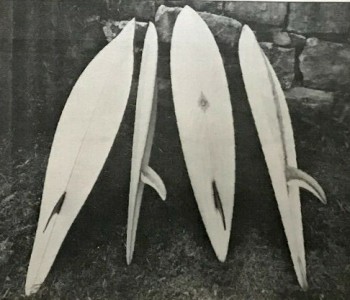 |
|
PETER [BERRY]'S PERSONAL
QUIVER
No. 1Dimensions: 5'7" x 26 1/2'' Built: September Design: Step bottom, full pintail with double rails. The rails are flexible for three-quarters the length of the board. Comment: Works well in long walled waves sized three to eight foot. It can ride a long way out from the curl and can do full rail cutbacks without the fin in the water. No. 2 Dimensions: 5'9" x 21 1/4" Built: August 1974 Design: Heavy double concave with kicked down narrow pintail. Comment: Works well in very fast waves. At high speeds it becomes highly manoeuvrable. Sits high in the lip. No. 3 Dimensions: 5'8" x 25" Built: August 1976. Design: Pin nose and tail with slight vee under nose and tail. Comment: A very loose board has the ability to hold in well in steep and critical sections. Will handle anything from three to 10 feet. No. 4 Dimensions: 6'3" x 21" Built: December 1970 Design: Pintail with slight vee in the tail. The first board I ever constructed with handles. Comment: A very versatile board that works well in all sorts of waves. It has been ridden successfully in everything from three to 15 feet. No. 5 Dimensions: 7'2" x 21 1/2'' Built: July 1973 Design: Has a step in the rail line, similar to a Stinger. It has a vee in the nose and tail. The bottom has two heavy concaves that form an air cushion. It has a two foot long Keel fin. Comment: It's a hard board to turn, but once it gets going it makes light work of heavy waves. No. 6 Dimensions: 6 0 x 20 1/2'' Built: (Not supplied) Design: Round tail with vee running the entire length of the board. It has double rails instead of conventional handles. Comment: Works best at high speed, not a slop riding board. - Surf [Aust] November 1977 Volume 1 Number 6 |
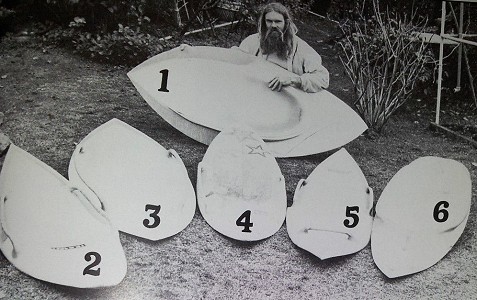 - Surf [Aust]
November 1977 Volume 1 Number 6.
 "a
bit of early 70's design weirdness"
Photograph : Tracks Archives Tracks Magazine: 20 Years Edition, October 1990, page 94. "Peter
Berry, a kneeboarder, also an amazing
left-field shaper,
his Cave Creature Designs feature flexible tails and rails. Also handles and step decks." - Simon Chipper, March 2006. 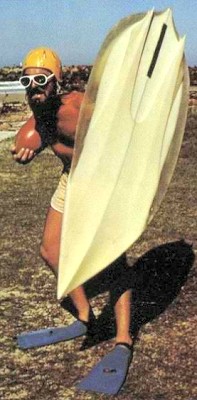 |
 |
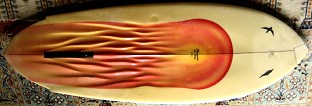 |


| home | catalogue | history | references | appendix |